Archives of Loren Williams Fly Tying Tutorials.
Hornberg
Fly and Photos by Loren Williams
The Hornberg was created by Frank Hornberg, a retired Conservation Officer for Wisconsin, and developed for commercial sale by the Weber Tackle Company. There are many color variations of this pattern, which is assumed to imitate a baitfish, but the recipe demonstrated is the most popular. The original most likely used black tying thread, but I favor red.
The Hornberg is tied as a dry fly although it usually gets listed as streamer. A typical presentation is a dead drifted dry fly until the patterns sinks, where it then gets fished as a streamers with an erratic retrieve. In smaller sizes, the Hornberg does a good job at imitating caddis and stoneflies.
MATERIALS
Hook: Mustad 80400 or equivalent
Thread: Red
Rib: Monofilament Thread
Body: Silver Mylar
Underwing: Yellow Chinese Hackle
Overwing: Mallard Flank
Cheeks: Jungle Cock
Hackle: Grizzly
Click photos to enlarge!

Place the debarbed hook in your vise.

Affix your thread using a jam knot at the front of the hook, back from the eye.

Secure the mono ribbing to the far side of the hook, using the entire shank to bind the material in place. Return the thread to the front.

Select some flat silver tinsel. I prefer the softer mylar tinsel which usually comes in dual colors. I am using a size 14 tinsel for this #6 hook as I find thinner tinsel makes nicer bodies.
Secure the tinsel at the front with 2 thread wraps. If the tinsel is dual colored, be sure the silver side is facing the hook.

Wrap the tinsel to the rear in tight and touching turns.
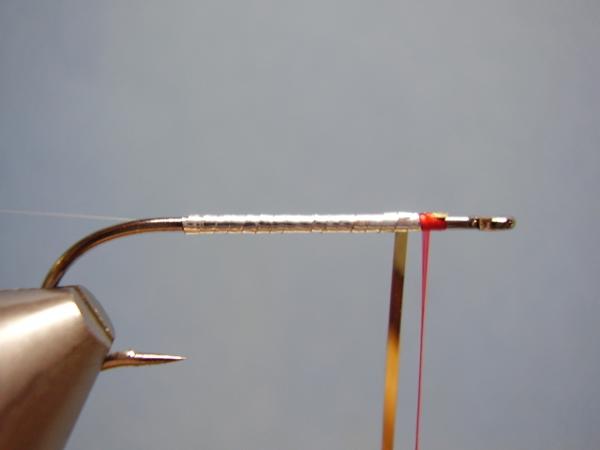
Once you reach the rear, reverse direction back forward being careful to make each wrap tight and touching.

Once you reach the front, unwrap the two thread wraps as the second layer is now holding the first in place.

Pass the last wrap over the shank and in front of the thread.

Bring it under the shank and hold it up and slightly back while you secure it with two thread wraps. Clip the excess.

Counter rib the tinsel with mono thread for durability. Try to make the wraps fairly open and quite tight. Finish as with the mylar.

Select four straight yellow hackles from a Chinese rooster cape (also called "saltwater capes").

Place the four feathers on top of each other and even the tips then measure them against the hook so that the tips reach about a hook gap's length beyond the bend.

Stroke down the barbs from the front measured point .

Strip the barbs from a short section of the stem.

Clip off the rest.

Select two of the four feathers and flatten the exposed stem with small needle nosed pliers.

Using 2 tight wraps secure them to the hook so that the stems are in line with the hook shank.
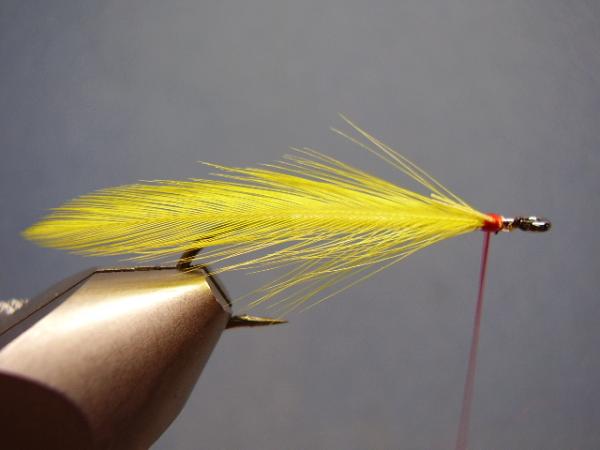
Fold the excess stems back and secure with 2 more wraps. This will prevent them from pulling out or rolling.

Repeat on the far side with the other two hackles, being sure the 4 tips are aligned.

Select two very large Mallard Duck flank feathers. A bit of curvature is desireable, if the feathers are too flat or too curved, simply wet them and stick them to an object with the appropriate curve (a jar for example) and allow them to dry.

Place one against the hook and measure it to extend just beyond the yellow hackles.
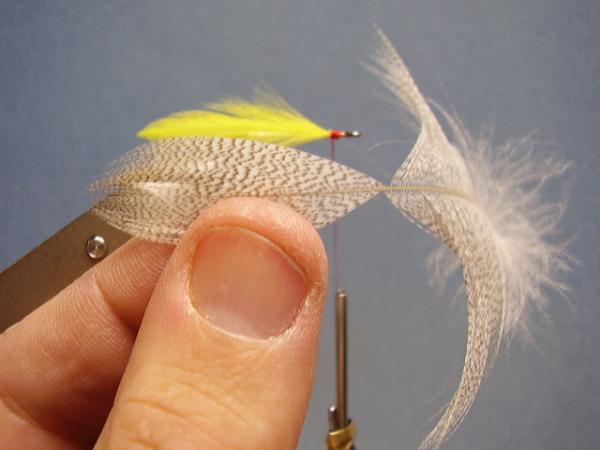
Stroke away the barbs from the front measured point.

Place it atop the other flank feather and even the tips.

Stroke away the barbs from the rear feather to mirror the top feather.

Strip the stroked barbs to expose a short section of stem and clip the excess. You are left with two identical flank feathers.

Select one feather and flatten the exposed stem.

Lay it against the shank and secure it with 2 thread wraps so that it envelopes the yellow hackle. Repeat on the far side with the other flank feather.

Fold the excess stems, on both sides, to the rear and secure with 2 thread wraps.

Clip the excess stems.

Find a quality Jungle Cock cape and elect two matched eyed feathers from near the top (narrow end) of the cape.
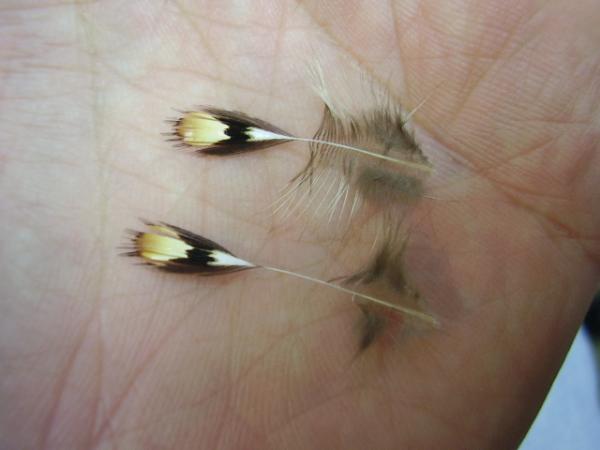
Stroke away the barbs to expose the two "eyes" as shown on the top feather, then remove the barbs as shown on the bottom.

Mount an eye on each side of the fly to form cheeks These too, should be in-line with the hook shank.

Select two light grizzly rooster hackles whose barbs are equal to about 2-times the gap of the hook.

Look for the webbing against the stem at the base of each feather and follow it up the stem until it disappears. At that point stroke away the barbs to expose the top sections of the hackles.

Clip off the bases, leaving a short section of stem form each hackle.

Place the feathers atop each other and secure them at the same time to the hook just in front of the wing making sure that the dull undersides are facing you.

Pull both hackles forward to crease the stems, they should now be at a rough 90-degree angle to the shank.

Wrap one feather forward in tight turns, stopping short of the eye and secure it with 2 thread wraps. Clip the excess.

Wrap the second hackle forward through the first making sure that it's first wrap is completely behind the first wrap of the initial hackle. This will create a neat rear edge to the hackle collar.

Proceed though the collar with the second hackle and secure in front with 2 thread wraps a bit behind the eye.

With 3 fingers full back all the hackle barbs and wrap a neat, small head.

Whip finish and clip the thread.
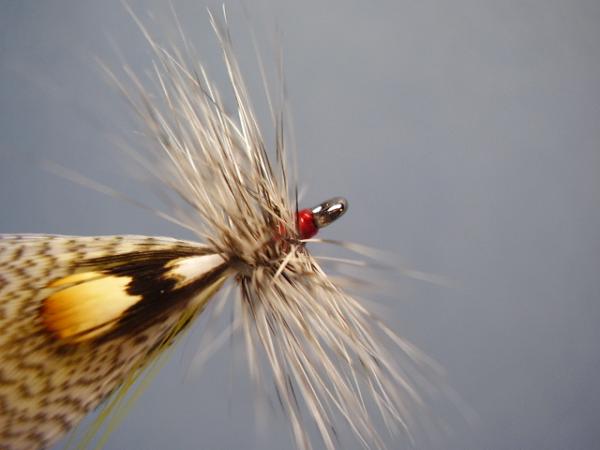
Tilt the fly up and add a few drops of head cement to seal the deal.

A drop of cement at the rear tips of the Mallard Flank will allow you to pinch them to a point and you'll be left with a completed Hornberg!